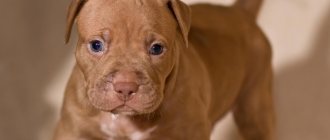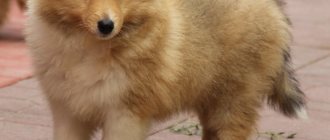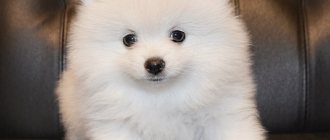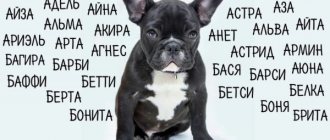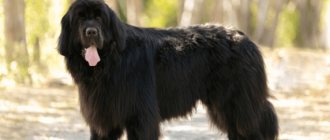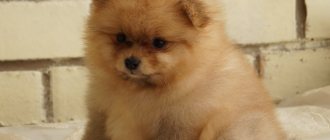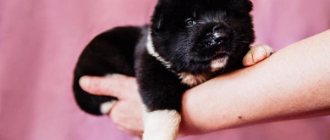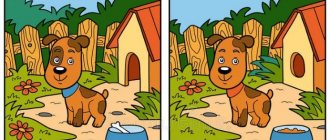Popular nicknames
A selection of the most popular Russian-language nicknames for representatives of the breed:
- Alec;
- Alexa;
- Bagryanka;
- Velvet;
- Lady;
- Bimka;
- Lady;
- Dominica;
- Esther;
- Thaddeus;
- Faina;
- Felix;
- Gala;
- Gavril;
- Gordy;
- Bitter;
- Captain;
- Kara;
- Cossack;
- Casimir;
- Clement;
- Kodiak;
- Princess;
- Space;
Boy Alec:
- Paw;
- Lariska;
- Weasel;
- Makar;
- Manya;
- Matron;
- Rachel;
- Rebus;
- Rufina;
- Sarah;
- Seraphim;
- Salt;
- Timur;
- Fog;
- Ursa;
- Valdai;
- Vasilisa;
- Loyal;
- Leader;
- Yup'ik;
- Dawn.
Girl Rufina:
Appearance of the Estonian hound
General impression
The Estonian Hound is a short dog with well-developed muscles and a strong, proportional build. She has elegant features, distinguishing her from the big-boned beagle with which some people confuse her. Indeed, in a photo it is easy to confuse an Estonian hound and a beagle, but in life their differences are striking.
Head
The skull is quite elegant, slightly wide, it smoothly, without a sharp break, passes to the elongated muzzle. The wide nose varies from black to brown, depending on the color of the animal. The brow ridges are clearly defined, the cheekbones are without obvious bulges. The Estonian's jaws are well developed, the teeth are white and large.
Neck
The muscles of the hound's medium-length neck are clearly visible. There are no skin folds.
Torso
The body is small but strong, with good muscles and a lean constitution. The height at the withers is noticeably less than the length of the body.
Forelegs
The paws are strong, dry, with developed muscles, look parallel, without bends. Their length is approximately equal to half the height of a hound. The pasterns are almost vertical.
Hind limbs
The hind legs are very powerful and bony. The thighs and shins are almost the same length. While running, the knee joints should not be twisted. The hocks are of medium length and vertical.
Tail
The tail is saber-shaped, tapering to a tip, and covered with thick, coarse hair. When moving, it does not rise above the back.
Movements
Fast, sometimes fussy. The dog is very agile, quickly picks up speed, and easily jumps over obstacles.
Wool
The Estonian Hound is the proud owner of a thick coat that is hard to the touch. Hair length is the same on all parts of the body. There is no undercoat. Moderate shedding occurs seasonally.
Color
This breed is characterized by a black and piebald color with reddish markings and blush. Possible brown-piebald, crimson-piebald color, reminiscent of a blanket put on a dog. The legs and tip of the tail of the Estonian remain completely white. This color is found on the head, chest, belly, and neck of a thoroughbred individual. In general, the colors of the Estonian Hound are not very diverse.
Size
The weight of the Estonian Hound varies from 11 to 20 kg. The height at the withers depends on the gender. The height of Estonian hounds for males is 45-52 cm, for females it is smaller, about 42-49 cm.
The size of the Estonian Hound allows you to keep the dog in a small apartment. At the same time, do not forget about good physical activity.
Nicknames popular abroad
A selection of Russian hound nicknames that are popular in foreign countries:
- Glory;
- Kazan;
- Snout;
- Thunder;
- Muncie;
- Cossack;
- Front sight;
- Ursa;
- Monya;
- Narcissa;
- Beauty;
- Mika;
- Rurik;
- Urola;
- Zaneta.
In the photo - Mansi:
Criterias of choice
The name for your hound should be unusual, especially if you plan to go hunting with several dogs. Your pet should be able to easily recognize its name and follow the command.
The nickname should be sonorous. Hunting involves long distances, so the louder and clearer the name, the faster the dog will react to it, even from a considerable distance. It is better to avoid voiceless consonant sounds.
The name should reflect the characteristics of the dog - behavior, external characteristics, voice, character. For example, Grozny has a stern disposition, Thunder has a loud voice, and it is impossible to keep up with the Wind.
Old nicknames
Names that have been given to survivors from time immemorial:
- Oshara;
- Plot;
- Hug;
- Polaz;
- Leak in;
- Warbler;
- Hilo;
- trample on;
- Rachilo;
- Rosilo;
- Good;
- Start singing;
- Zepalo;
- Norman;
- Enthusiasm;
- Call;
- Pravdilo;
- Excite;
- Light up;
- Crush;
- Horse;
- Yarilo;
- Plowshare;
- Mine;
- Bully;
- Dobych;
- Starling;
- Bassoon;
- Gaboy;
- Ostan;
- Zhurilo;
- Comfort;
- Greed;
- Push around;
- Nightingale;
- Alarm;
- Play;
- Roll;
- Palilo;
- Grachik;
- additional;
- Crow;
- Savage;
- Horn;
- Canary;
- Annoy;
- Flash;
- Talk;
- Kashmilo;
- Bandor;
- Rage.
Russian hound Roll:
Next is a selection of old nicknames for catches:
- Shumka;
- Design;
- Defeat;
- Vesta;
- Zaston;
- Galda;
- Tap dancing;
- Pretty;
- Klikusha;
- Khoroshavka;
- Singer;
- Anxiety;
- Rachishka;
- Leak;
- Start;
- Norm;
- Pomchishka;
- Cool;
- Zaklika;
- Blush;
- Ignition;
- Crixa;
- Mining;
- Skvorka;
- Zhurishka;
- Consolation;
- Screamer;
- Magpie;
- Solovka;
- Zadorka;
- Jackdaw;
- Dokuka;
- Flute;
- Canary;
- Kutishka;
- Gromishka;
- Racket;
- Shumka;
- Arava.
Her name is Vesta:
Nicknames of hounds V. Timofeev
This Russian flavor in hound dog breeding is primordial, it must be carefully preserved. The point, of course, is not only a matter of fashion, which is diligently followed by old hounds and adopted by young ones, but also that there is a pattern in the relationship between the breed of dogs and their nicknames, just as there is a pattern in tobacco-growing terminology, determined by the nature of the work and the purpose of the dogs. Carelessness in terminology and in assigning nicknames reduces the culture of dog breeding and neutralizes its industry characteristics.
Such hound names as Alba, Alma, Bandit, Geisha, Jack, Diana, Dinka, Irma, Token, Kazan, Palma, Pirate, Tangai, Tarzan, Fairy, Shaitan and the like are alien to the breed, and the one who appropriates them hound cannot be called a real hound.
Some dog breeders give their helpers . on the hunt, dissonant nicknames: Kholui, Snoring, Grunting, and so on.
In order to organize the names of hound dogs, I offer a dictionary of nicknames, which, from my point of view, are suitable for this breed in terms of meaning and euphony.
The nicknames, as you can see, have different meanings: sound and noise effects (Thunder, Alarm), names of musical instruments and terms (Bayan, Svirel, Minorca), vocal names (Song, Pevka), active actions (Zador, Light up), hunting, field actions (Get, Pomikay), names of natural phenomena (Blizzard, Blizzard), finally, names indicating that hunting with hounds itself is a great art and entertainment (Fun, Amuse), etc.
The hounds' nicknames are also expressive through word-formation means. Verb stems are supplemented with prefixes with active action meanings: you (Pay), to (Get), for (Punte), on (Raid), by (Amuse). Verbal stems with the suffixes -un, -ilo are widely used in the nicknames of hounds, expressing the meaning of a tendency to action: Plakun, Budilo (a). The nicknames of the survivors are also characterized by the use of verb endings in the imperative mood: Rush, Cry, Fill. The nicknames of the vyzhlovs are decorated with the suffix -k, which, with the meaning of the feminine gender, also expresses the meaning of endearment: Dobychka, Zadorna, Anxious. The suffix -ushk is especially emotional - Talker, Rumble.
Nicknames for survivors: Bayan, Tambourine, Budilo, Bushui, Brawl, Flash, Cry, Guy, Guess, Talk, Thunder, Hoot, Hum. Dobor, Get, Catch up, Catch up, Annoy, Amuse, Fervor, Fill, Sing, Start, Ring, Karai, Beat the Alarm, Raid, Cryer, Cry, Signal, Sorochay, Sing, Trumpeter, Trunil, Hurricane, Console, Laughter, Laughing , Shugai, Shumilo.
Nicknames for survivors: Budushka, Storm, Voltorka. Second, Blizzard, Hyda, Talker, Rumble, Booty, Fun, Teaser, Zadorka, Ignition, Sweetheart, Trick, Spark, Kenarka, Krutishka, Lute, Blizzard, Mark, Dream, Minorca, Reward, Note, Singing, Song, Blizzard, Pipe, Fairy Tale, Violin, Nightingale, Singing, Arrow, String. Taiga, Anxiety, Anxious, Trunishka, Joy, Consolation, Flute, Laughter, Shnyrka, Shumka.I
It is a pity that modern hound breeders do not pay attention to such an important issue for breeding as giving nicknames to the entire litter based on the same initial letter of the father’s or mother’s nickname, which makes it easier to monitor the quality of the litter. It is necessary to revive the old traditions of Russian dog breeding.
V. Timofeev,
Candidate of Philology
Nicknames for Estonian hound girls
Jessie, Bucky, Candy, Stacy, Molly, Zara, Richie, Chasey, Penny, Chucky, Dina, Tori, Barca, Sally, Sandy, Doxy, Poly, Dusya, Angel, Blackie, Venus, Vicky, Vega, Tosya, Alba, Gucci, Gloria, Goldie, Alma, Amber, Bertha, Viva, Lucy, Cessa, Gretta, Laura, Ulli, Piggy, Lexi, Abby, Fanny, Taska, Selina, Ulma, Paris, Dolly, Gizma, Miley, Sophie, Keri, Sanda, Maya, Moska, Nika, Nancy, Kara, Cleo, Salma, Bella, Gabi, Dana, Lilu, Cher, Elsa, Remy, Diya, Zhulya, Busya, Hanny Perry, Shelley, Bessie, Lily, Helga, Ilsa, Sherry , Irma, Jeta, Ollie, Party, Pixie, Roxy, Kira, Kenya, Chloe, Bonya, Dixie, Tiara, Taya, Ulka, Viol, Zhuchka, Zlata, Utah, Yumi, Sheldi, Holdie, Chelsea, Cherry, Chita, Chessa , Elba.
Hounds are one of the oldest groups of dogs (including such hunting breeds as, for example, Bloodhound, Steggound, Harrier, Foxhound, Beagle, Otherhound, Russian Hound). A feature of hounds that differs from other dogs is the ability to pursue an animal with their voice. Naming hound puppies has its own history and traditions. Their nicknames in one way or another reflect the spirit of hunting. Hound names can be divided into four categories:
Traditions of choosing names for hound litters
There are certain traditions associated with choosing names for hounds and hunting. In ancient times, nicknames were usually given in an ethnic style. Among greyhounds, the names reflect the beauty of these dogs, their running speed and anger at animals: Krylat, Lyubesny, Zlorad, Swan, Sudarik, Dove, Luck and Ulcer. Another very interesting and unusual tradition is to use verbs as names: Torment or Catch up.
The hounds were also called “musical” names: Alarm, Canary, Rout, Ringing, Lute, Magpie, Scandal, Alarm. Russian hunters valued the sounds of hounds even more than pompous hunters in France: they not only focused on sound, but also required a variety of tones and timbres, that is, complex sounds. The dogs were first recruited into the pack based on their physical characteristics, and then the dogs’ vocality was examined. The only purpose of older people attending hound hunts is to hear the rutting of the prey.
List of the best names for hunting dogs
A girl puppy can be called Gulka, Frisky, Yelp, Zvonka, Mischievous, Nursery Rhyme, Ditty, Flute, Shumka, Zvonila. Among foreign nicknames, Loud, Bell, Noisy are suitable.
Boys are given names such as Shumok, Viola, Hooter, Help Out, Call, Krikun, Whistle, Get. Rokot, Danube, Nightingale.
Personality of the Estonian Hound
Despite the high hunting qualities, assertiveness and mercilessness when catching animals, this breed of dogs is kept as pets. They show great love for their owners and friendliness towards others. The Estonian woman leaves all her anger for hunting, but at home she becomes affectionate, devoted, and obedient. The kind, patient nature of the Estonian hound allows it to be kept in an apartment where small children live. The hound takes their pranks calmly. But the most important thing for the Estonian will be the owner, perceived as the leader of the pack.
Other animals living nearby are considered her friends if they grew up together. When not a puppy, but an adult dog comes into the house, it will take a lot of time to eliminate conflicts and clashes that occur with other pets. Cats will especially get it.
The Estonian Hound is a very clean dog, keeping it in an apartment will not be a problem for the owner. You just need to remember about your pet’s ebullient energy, which it will expend on long walks. Country houses are still considered the best habitat, where the animal is kept indoors in winter and outside in an enclosure in summer.
Those who are suited to the hunting qualities of a hound note the early manifestation of working skills. By six months, she begins to sniff and pick up the animal's trail. By the year they show all the excitement and aggressiveness, bringing good trophies. The external characteristics of the pet are their advantage, not giving the game a chance to escape from the pursuer.
Your pet will be an excellent watchman thanks to its intelligence, courage and bravery.
